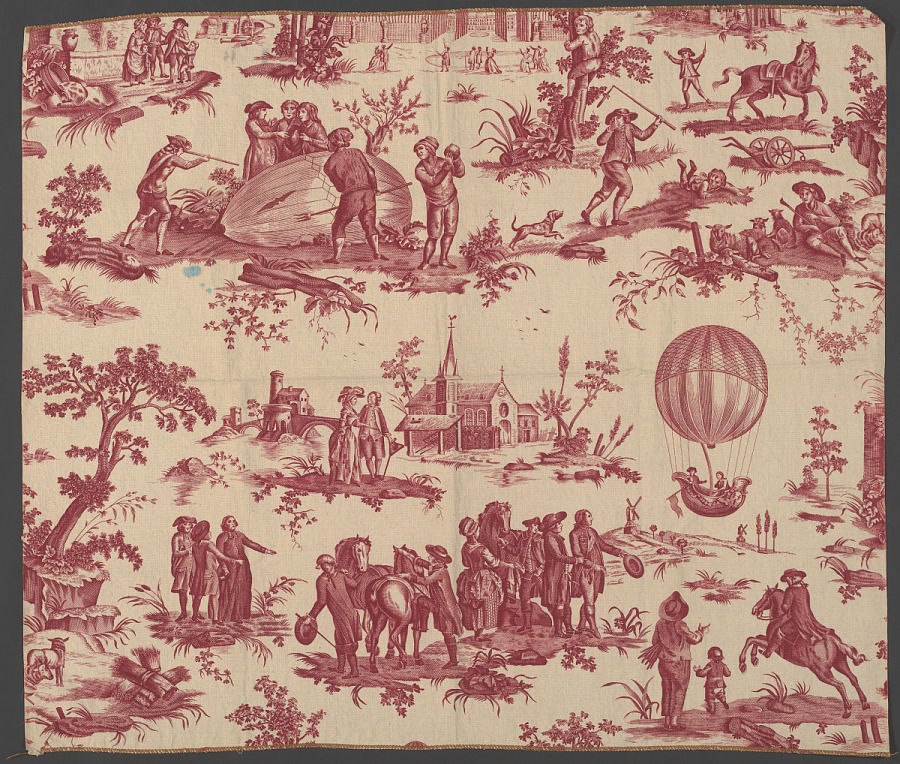Haute Science: On Science in Fashion
- Alexandra Vasilyeva

- May 17
- 4 min read
The last fortnight has been rich on fashion events, including the famous first Monday in May at the Met Gala, and the less famous but more local to me Berlin Design Week.
This, of course, got my one-track mind thinking about science. Let me explain.
It started with this dress, which I came across on an exhibition about Enlightenment in the German History Museum:

Looks kind of dull, right? I wondered what it was doing in a display about scientific revolutions – and then I saw the detailing. Balloons! Of course. The balloon craze.
Balloons may look tame now, but in the late 18th century, they were anything but. For the first time in history, human beings gained the ability to (kind of) fly. This led to both fascinating scientific explorations and intensely popular spectacles, akin to that captured in season 3 of Bridgerton. And, despite Bridgerton being delightfully unhistoric, it happens that the balloon craze was really Just Like That. Bizarre at first glance, but it does make sense in the context of the Enlightenment, when science took a decidedly empirical turn, and scholarship occasionally moonlighted as showmanship on popular demonstrations.
The ballgown in the photo above does look very bespoke, though, and out of grasp of most women. Improvements in textile making and decorating technologies, far from cooling the public interest, enabled more ladies to express their balloon love – consider, for example, this popular Toile de Jouy fabric print:

Balloonmania eventually died down, making way for other technologies, and fashion followed suit. Late 19th century costumes and advertisements do not disappoint, celebrating zeppelins, electricity, telegraph, photography and other technological delights.


And who said that scientific fashion is impractical? Consider these wonderful lightning rod hats for ladies, which got popular in France around 1778 and even featured a thin metal chain dragging behind on the ground. These ladies had better electrical grounding than some lab equipment. And worry not, gentlemen were safe too: they had lightning rod umbrellas. A more stylish science accessory than a smart watch if you ask me, and less judgy by far.

Modern fashion generally does not hold a candle to these delights, with an average person expressing their love of technology with a cringey T-shirt. That said, some fashion designers do keep it up admirably.
Take, for instance, the famous British designer Alexander McQueen: although generally known as a fashion rebel, his work is also notable for often commenting on mental illness, human body and nature. In the 2011 Met Gala and the accompanying exhibition Savage Beauty, which celebrated his life and work, some of his most notable pieces were a dress with a bodice made out of red microscope slides (a medical statement outfit if ever I saw one), and a gown entirely made of razor clamshells (marine biologists, watch out).

The medical theme is further developed by Robert Wun in his Fall/Winter 2024 collection, which included four looks symbolizing the layers of the human body: Skin, Muscle, Bone and Soul. All of these, in particular the Soul gown, which used 97,000 crystals and required 1,430 hours of hand work, are simply mesmerizing to watch.

A different angle on science fashion was developed by a designer/scientist team Helen Storey and Tony Ryan at the UAL Centre for Sustainable Fashion: the project Catalytic Clothing featured a series of events promoting cleaner air, as well as a centrepiece gown coated with an air-purifying photocatalyst.

There is also certainly a trend towards structurally complicated (and sometimes even moving) clothing. One designer who incorporated a lot of structure in her work, enabled by modern materials and technologies such as 3D printing, is Iris van Herpen. Centered around the human body and its relationship to movement and environment, some of her pieces are also delightfully mathematic.

And lastly, I wanted to highlight a collection that is unique in that it is genuinely suitable for everyday wear. A collection for &Other Stories created by the data-driven designer Giorgia Lupi celebrated three women via data visualization: Ada Lovelace (the first computer programmer), Rachel Carson (a leading environmentalist) and Mae Jemison (the first African American woman astronaut). As someone who has had nightmares about Excel, I can attest that this is data viz at its best – would wear in a heartbeat.


All in all, I feel like we scientists have no excuses left. T-shirts with horrible puns are officially no longer the only way to express science love through wardrobe.
Comments